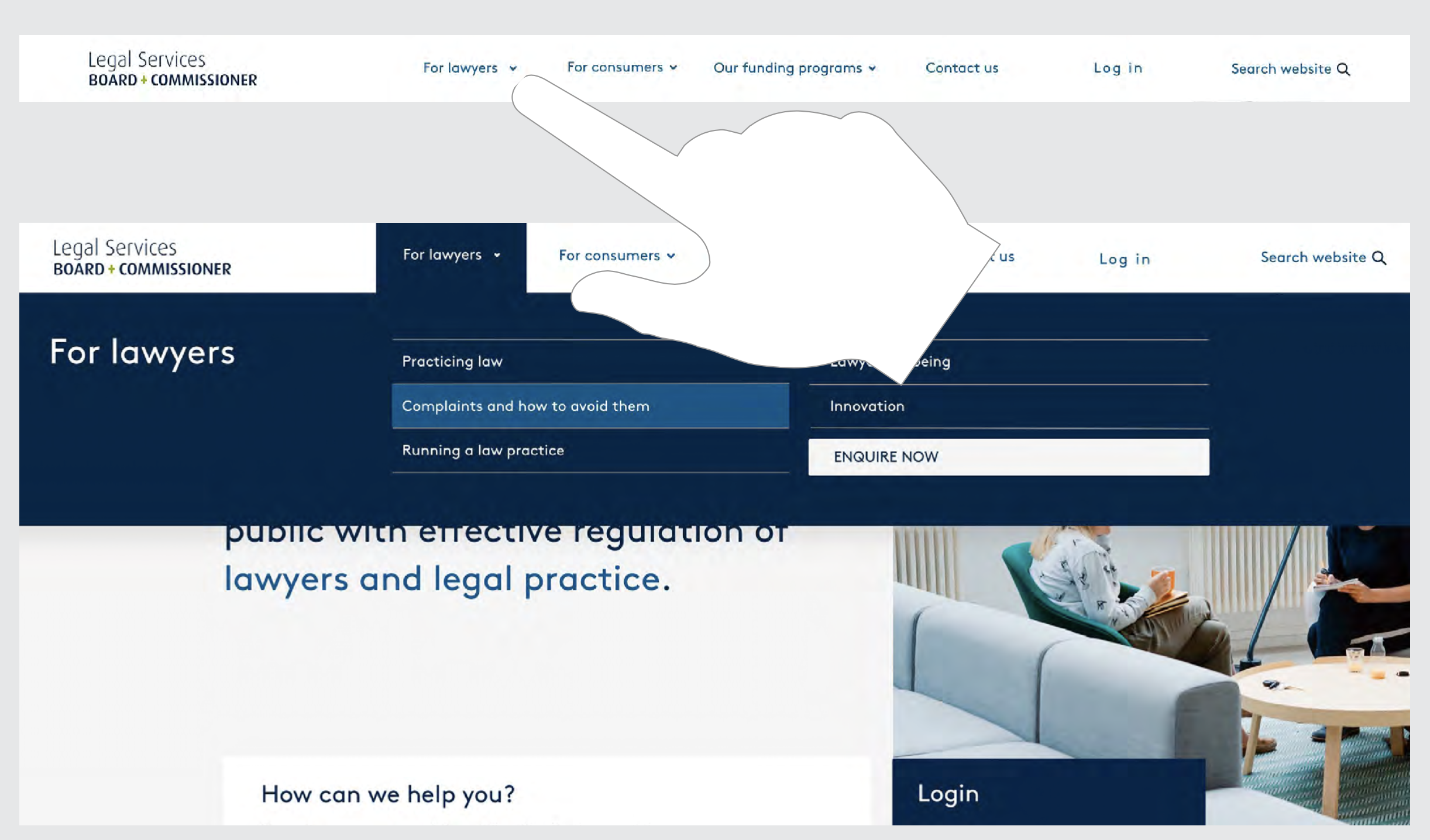VLSB+C
UX research, UX and UI design
2019
A new information architecture and user interface helped VLSB+C to improve their online presence. The new website makes the legal support provided by VLSB+C to consumers and lawyers friendly and accessible thanks to navigation designed around the user needs.
Objectives
Objectives
- Control the narrative and the story told to key audience.
- Talk the language understood by all audiences and to have a cohesive voice and identity.
-
Maintain public trust between the legal profession and consumers
-
Protect consumers by enabling them to understand how VLSB+C can
assist them
-
Support legal practitioners
-
Enable digital self-service as primary service delivery channel.
- Maintain findability of key items, such as public register of lawyers.
Interviews
Nine face-to-face interviews have been conducted with internal stakeholders to understand their goals in relation to the website and learn through their lens how they can better service practitioners and consumers through the website.
Additionally, five practitioner and four consumer interviews have explored their perception of VLSB+C and their goals as they interact with the website. They also had the opportunity to share how they thought it could be improved.
The interviews revealed that the website didn’t help the practitioners and consumers finding the information they’re looking for due to the lack of structure of the information architecture.
Practitioners stated that they would normally visit the website directly. They also noticed that the registry of lawyers and disciplinary actions was hard to find. Those services are valuable services for all lawyers.
Consumers instead and on the website mostly via Google Search and they had to navigate several pages to find the contents related to their needs.
Several partecipants also mentioned they prefer a clear separation of content between ‘Lawyer’ and ‘Consumer’ focused information.
Landscape review
A landscape review has been run to explore and gain insights to the IA via parallel industries, navigation patterns and web concepts with a strong focus on legal and governament services.


Information architecture
The website is a primary way for VLSB+C to communicate with the public. the objective of the new design is to tell the right stories.
The primary navigation has been divided into three core sections focused around the key audience: lawyers, consumers, and those seeking funding.
A global search function has been added so the users can find all types of content in one place.
Site structure supports the dynamic contents and story-telling through:
- News with considered taxonomy/categories that can be shared in the context of particular sections
-
Case studies to provide transparency and set expectations.
- Related content and stories are teased and linked throughout the website.

71%
success rate from 61 responsesLawyers/Legal professionals
54.8% success rate from 18 responses
Internal staff
77.6% success rate from 43 responses
Treejack test and validation
In order to test the usability of the proposed information architecture for the redesigned VLSB+C website, a Treejack test has been conducted.
The test had five tasks to complete, each asking the participant where they would expect to find a certain piec of content. The task order was randomised for each participant.

In order to further validat the proposed information architecture nine usability testing session on the high level wireframes have been conducted.
It has been ensure the partecipants rappresent a mix of genders, locations, legal professions and general public.
Participants were recruited either through departmental or through a specialist recruitment company.
The sample was composed of five lawyers and four members of the public to represent a broad mix of roles, responsibilities (types), ages.
Solution
The answer is the user pain point in regard to finding information on the website, the users are invited to search specific queries. Filtering and suggested queries provide significant search results.
Fact sheets are based on common customers and practitioner needs and information of legal services on a range of topics, such as costs disputes, and negligence.


First level pages guide the user to content pages about their audience-specific needs.

The content pages (second level) have been designed to allow the users who land on the page via Google Search to navigate the contents in a contextual way.
In the second-level pages a list of anchor links help the user to find the information inside the page while on the right side, the contextual menu allows the user to navigate pages in the audience specific section.
Documents and external links are highlighted so the user can identify them at a glance.
![]()
The navigation is based on a dropdown menu that allows the user to explore the second level pages under each first levels allowing them to discover the topics specific to their audience.
![]()
In the second-level pages a list of anchor links help the user to find the information inside the page while on the right side, the contextual menu allows the user to navigate pages in the audience specific section.
Documents and external links are highlighted so the user can identify them at a glance.

The navigation is based on a dropdown menu that allows the user to explore the second level pages under each first levels allowing them to discover the topics specific to their audience.
